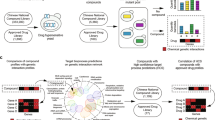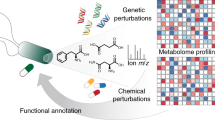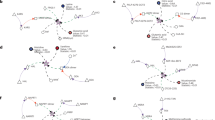Abstract
A major challenge in drug discovery is to distinguish the molecular targets of a bioactive compound from the hundreds to thousands of additional gene products that respond indirectly to changes in the activity of the targets1,2,3,4,5,6,7,8. Here, we present an integrated computational-experimental approach for computing the likelihood that gene products and associated pathways are targets of a compound. This is achieved by filtering the mRNA expression profile of compound-exposed cells using a reverse-engineered model of the cell's gene regulatory network. We apply the method to a set of 515 whole-genome yeast expression profiles resulting from a variety of treatments (compounds, knockouts and induced expression), and correctly enrich for the known targets and associated pathways in the majority of compounds examined. We demonstrate our approach with PTSB, a growth inhibitory compound with a previously unknown mode of action, by predicting and validating thioredoxin and thioredoxin reductase as its target.
This is a preview of subscription content, access via your institution
Access options
Subscribe to this journal
Receive 12 print issues and online access
$209.00 per year
only $17.42 per issue
Buy this article
- Purchase on Springer Link
- Instant access to full article PDF
Prices may be subject to local taxes which are calculated during checkout




Similar content being viewed by others
References
Hughes, T.R. et al. Functional discovery via a compendium of expression profiles. Cell 102, 109–126 (2000).
Courcelle, J., Khodursky, A., Peter, B., Brown, P.O. & Hanawalt, P.C. Comparative gene expression profiles following UV exposure in wild-type and SOS-deficient Escherichia coli. Genetics 158, 41–64 (2001).
Bredel, M. & Jacoby, E. Chemogenomics: an emerging strategy for rapid target and drug discovery. Nat. Rev. Genet. 5, 262–275 (2004).
Miklos, G.L.G. & Maleszka, R. Microarray reality checks in the context of a complex disease. Nat. Biotechnol. 22, 615–621 (2004).
Giaever, G. et al. Genomic profiling of drug sensitivities via induced haploinsufficiency. Nat. Genet. 21, 278–283 (1999).
Giaever, G. et al. Chemogenomic profiling: identifying the functional interactions of small molecules in yeast. Proc. Natl. Acad. Sci. USA 101, 793–798 (2004).
Lum, P.Y. et al. Discovering modes of action for therapeutic compounds using a genome-wide screen of yeast heterozygotes. Cell 116, 121–137 (2004).
Parsons, A.B. et al. Integration of chemical-genetic and genetic interaction data links bioactive compounds to cellular target pathways. Nat. Biotechnol. 22, 62–69 (2004).
Marton, M.J. et al. Drug target validation and identification of secondary drug target effects using DNA microarrays. Nat. Med. 4, 1293–1301 (1998).
Stoughton, R. & Friend, S.H. Methods for identifying pathways of drug action. US Patent No. 5,965,352 (2003).
Bar-Joseph, Z. et al. Computational discovery of gene modules and regulatory networks. Nat. Biotechnol. 21, 1337–1342 (2003).
Beer, M.A. & Tavazoie, S. Predicting gene expression from sequence. Cell 117, 185–198 (2004).
Covert, M.W., Knight, E.M., Reed, J.L., Herrgard, M.J. & Palsson, B.O. Integrating high-throughput and computational data elucidates bacterial networks. Nature 429, 92–96 (2004).
de la Fuente, A., Brazhnik, P. & Mendes, P. Linking the genes: inferring quantitative gene networks from microarray data. Trends Genet. 18, 395–398 (2002).
Gardner, T.S., di Bernardo, D., Lorenz, D. & Collins, J.J. Inferring genetic networks and identifying compound mode of action via expression profiling. Science 301, 102–105 (2003).
Gasch, A.P. et al. Genomic expression programs in the response of yeast cells to environmental changes. Mol. Biol. Cell 11, 4241–4257 (2000).
Herrgard, M.J., Covert, M.W. & Palsson, B.O. Reconstruction of microbial transcriptional regulatory networks. Curr. Opin. Biotechnol. 15, 70–77 (2004).
Ideker, T. et al. Integrated genomic and proteomic analyses of a systematically perturbed metabolic network. Science 292, 929–934 (2001).
Liao, J.C. et al. Network component analysis: reconstruction of regulatory signals in biological systems. Proc. Natl. Acad. Sci. USA 100, 15522–15527 (2003).
Rice, J. & Stolovitzky, G. Making the most of it: pathway reconstruction and integrative simulation using the data at hand. Drug Discov. Today: BioSilico 2, 70–77 (2004).
Ronen, M., Rosenberg, R., Shraiman, B.I. & Alon, U. Assigning numbers to the arrows: parameterizing a gene regulation network by using accurate expression kinetics. Proc. Natl. Acad. Sci. USA 99, 10555–10560 (2002).
Tegner, J., Yeung, M.K., Hasty, J. & Collins, J.J. Reverse engineering gene networks: integrating genetic perturbations with dynamical modeling. Proc. Natl. Acad. Sci. USA 100, 5944–5949 (2003).
Yeung, M.K.S., Tegner, J. & Collins, J.J. Reverse engineering gene networks using singular value decomposition and robust regression. Proc. Natl. Acad. Sci. USA 99, 6163–6168 (2002).
Kholodenko, B.N. et al. Untangling the wires: a strategy to trace functional interactions in signaling and gene networks. Proc. Natl. Acad. Sci. USA 99, 12841–12846 (2002).
Hartemink, A.J., Gifford, D.K., Jaakkola, T.S. & Young, R.A. Combining location and expression data for principled discovery of genetic regulatory network. Proc. Pacific. Symp. Biocomp. 7, 437–449 (2002).
Kalir, S. & Alon, U. Using a quantitative blueprint to reprogram the dynamics of the flagella gene network. Cell 117, 713–720 (2004).
Schmitt, W.A.J., Raab, R.M. & Stephanopoulos, G. Elucidation of gene interaction networks through time-lagged correlation analysis of transcriptional data. Genome Res. 14, 1654–1663 (2004).
Dempster, A., Laird, N. & Rubin, D. Maximum likelihood from incomplete data via the EM algorithm. J. R. Stat. Soc. [Ser. B] 39, 1–38 (1977).
Mnaimneh, S. et al. Exploration of essential gene functions via titratable promoter alleles. Cell 118, 31–44 (2004).
Ueda, M. et al. Effect of catalase-specific inhibitor 3-amino-1,2,4-triazole on yeast peroxisomal catalase in vivo. FEMS Microbiol. Lett. 219, 93–98 (2003).
Chabes, A. et al. Survival of DNA damage in yeast directly depends on increased dNTP levels allowed by relaxes feedback inhibition of ribonucleotide reductase. Cell 112, 391–401 (2003).
Kanehisa, M. & Goto, S. KEGG: Kyoto Encyclopedia of Genes and Genomes. Nucleic Acids Res. 28, 27–30 (2000).
Bennett, C. et al. Genes required for ionizing radiation resistance in yeast. Nat. Genet. 29, 426–434 (2001).
Hand, R.A., Jia, N., Bard, M. & Craven, R.J. Saccharomyces cerevisiae Dap1p, a novel DNA damage response protein related to the mammalian membrane-associated progesterone receptor. Eukaryot. Cell 2, 306–317 (2003).
Holmgren, A. & Reichard, P. Thioredoxin 2: cleavage with cyanogen bromide. Eur. J. Biochem. 2, 187–196 (1967).
NCBI Gene Expression Omnibus: http://www.ncbi.nlm.nih.gov/geo.
Stanford Microarray Database: http://genome-www5.stanford.edu.
The Alliance for Cellular Signaling: http://www.signaling-gateway.org/.
Eisen, M.B. & Brown, P.O. DNA arrays for analysis of gene expression. Meth. Enzymol. 303, 179–205 (1999).
Hastie, T., Tibshirani, R. & Friedman, J. The Elements of Statistical Learning: Data Mining, Inference, and Prediction (Springer, New York, 2001).
Klobucnikova, V. et al. Terbinafine resistance in a pleiotropic yeast mutant is caused by a single point mutation in the ERG1 gene. Biochem. Biophys. Res. Commun. 309, 666–671 (2003).
Rine, J., Hansen, W., Hardeman, E. & Davis, R.W. Targeted selection of recombinant clones through gene dosage effects. Proc. Natl. Acad. Sci. USA 80, 6750–6754 (1983).
Daum, G., Lees, N.D., Bard, M. & Dickson, R. Biochemistry, cell biology and molecular biology of lipids of Saccharomyces cerevisiae. Yeast 14, 1471–1510 (1998).
Rittberg, D.A. & Wright, J.A. Relationships between sensitivity to hydroxyurea and 4-methyl-5-amino-1-formylisoquinoline thiosemicarbazone (MAIO) and ribonucleotide reductase RNR2 mRNA levels in strains of Saccharomyces cerevisiae. Biochem. Cell Biol. 67, 352–357 (1989).
Stocklein, W. & Piepersberg, W. Binding of cycloheximide to ribosomes from wild-type and mutant strains of Saccharomyces cerevisiae. Antimicrob. Agents Chemother. 18, 863–867 (1980).
Barnes, G., Hansen, W.J., Holcomb, C.L. & Rine, J. Asparagine-linked glycosylation in Saccharomyces cerevisiae: genetic analysis of an early step. Mol. Cell Biol. 4, 2381–2388 (1984).
Gaughran, J.P., Lai, M.H., Kirsch, D.R. & Silverman, S.J. Nikkomycin Z is a specific inhibitor of Saccharomyces cerevisiae chitin synthase isozyme Chs3 in vitro and in vivo. J. Bacteriol. 176, 5857–5860 (1994).
Anderson, R.M. et al. Yeast life-span extension by calorie restriction is independent of NAD fluctuation. Science 302, 2124–2126 (2003).
Acknowledgements
Support for this work was provided by the Department of Energy, the National Institutes of Health, the National Heart, Lung and Blood Institute Proteomics Initiative, the Whitaker Foundation, the National Science Foundation, the Fondazione Telethon, Boston University and the Pharmaceutical Research and Manufacturers of America Foundation.
Author information
Authors and Affiliations
Corresponding author
Ethics declarations
Competing interests
Provisional patent applications have been filed on the MNI algorithm and the PTSB compound.
Supplementary information
Supplementary Table 1
TET-inducible experiments: comparison between normal and modified z-scores (PDF 21 kb)
Supplementary Table 2
Treatment with drugs: comparison between normal and modified z-scores (PDF 23 kb)
Supplementary Table 3
Pathways involved in compound mode of action: MNI approach versus mRNA expression change (PDF 15 kb)
Supplementary Table 4
Pathways involved in compound mode of action: Association analysis approaches (PDF 15 kb)
Supplementary Table 5
Top 50 ranked genes (MNI) Drugs with known targets Drugs without well-established targets (PDF 24 kb)
Rights and permissions
About this article
Cite this article
di Bernardo, D., Thompson, M., Gardner, T. et al. Chemogenomic profiling on a genome-wide scale using reverse-engineered gene networks. Nat Biotechnol 23, 377–383 (2005). https://doi.org/10.1038/nbt1075
Published:
Issue Date:
DOI: https://doi.org/10.1038/nbt1075
This article is cited by
-
Learning perturbation-inducible cell states from observability analysis of transcriptome dynamics
Nature Communications (2023)
-
Drug target inference by mining transcriptional data using a novel graph convolutional network framework
Protein & Cell (2022)
-
Entropy of a bacterial stress response is a generalizable predictor for fitness and antibiotic sensitivity
Nature Communications (2020)
-
Efficient proximal gradient algorithm for inference of differential gene networks
BMC Bioinformatics (2019)
-
Olfactory receptor 10J5 responding to α-cedrene regulates hepatic steatosis via the cAMP–PKA pathway
Scientific Reports (2017)



